
table of contents
- Recognize the vinepox mite
- Combat
- Remove infected leaves
- Use predatory mites
- Bring out gall mosquito larvae
- Use lace flies
- Use neem oil
- Splash nettle broth
- Effective prevention
- frequently asked Questions
The grape pox mite is a type of mite from the gall mite family. She appears on grapevines. We present 6 home remedies to fight the mite and show how prevention works.
In a nutshell
- the pox mite is a gall mite that attacks grapevines
- Pests suckle on the grape leaves
- Damage: pox-like elevations on the upper side of the leaf, felt-like hairs on the underside of the leaf
- Larvae overwinter on the plant
- Biological spray solutions or predatory mites provide a remedy
Recognize the vinepox mite
The vinepox mites (Colomerus vitis) are so small with a length of 160 to 200 micrometers that they cannot be seen with the naked eye. They belong to the gall mite family.
Smallpox mites overwinter in the buds of the grapevines. As soon as the young vine leaves emerge, the activity of the mites begins. They suck on the leaves and produce typical damage.
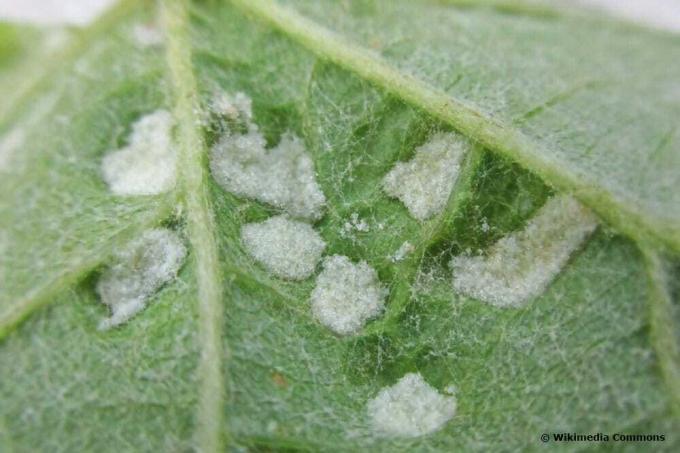
Damage:
- Visibility of the infestation shortly after the new shoots in spring
- pox-like bumps on top of leaves
- the bubbles or Smallpox is partly yellowish, greenish or reddish in color
- white felt-like coating on the underside of the leaves
- more pronounced damage in the event of persistent drought
Note: Due to the white felt on the underside of the leaf, it is often mistaken for powdery mildew. The top of the sheet provides information about the cause.
Incidentally, even if the damage pattern is clearly pronounced, an infestation with the smallpox mite has little effect on the harvest yield.
Combat
Don't resort to chemical pesticides right away. Even simple home remedies lead to success. We have put together 6 tips for you to fight the vinepox mite.
Remove infected leaves
Cut off the damaged leaves. Collect the leaves carefully and dispose of them with household waste.
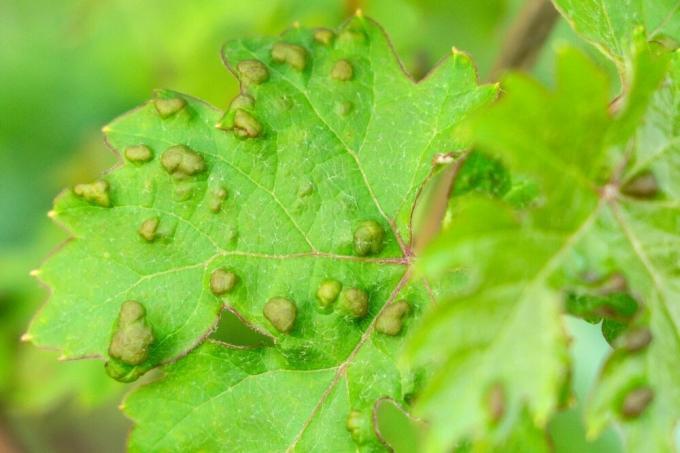
Note: Plant parts that are infected with pests or diseases do not belong on the compost. Pathogens can spread by spreading the compost.
Use predatory mites
Predatory mites, for example of the Typhlodromus pyri variety, are natural enemies of the vinepox mites. They are between 0.4 and 0.8 millimeters in size and are strikingly yellow or orange in color.
You can purchase the predatory mites from specialist gardeners. Their use is considered to be the most effective biological means to combat the vinepox mite. Incidentally, the predatory mites also eat other mites. Predatory mites are used in viticulture and fruit growing to prevent pest infestation effectively and at an early stage.
Tip: Predatory mites help against harmful mite species such as the common spider mite, the fruit tree spider mite and the green mite. You do not cause any damage to the infected plants yourself. In organic agriculture, stable colonies with useful predatory mites can develop, which permanently displace pests.
Use: Typhlodromus pyri is offered in specialist shops on felt strips or cards. Distribute these on the affected vines. Observe the manufacturer's instructions for use.
Bring out gall mosquito larvae
Like predatory mites, the larvae of the gall midges are natural enemies of the vinepox mites. Gall mosquitoes lay their eggs near the vinepox mites. When the larvae hatch, they destroy the harmful mites. Gall mosquito larvae are effective against aphids and Spider mites used. The gall mosquito species Aphidoletes aphidimyza and Episyrphus balteatus are useful.
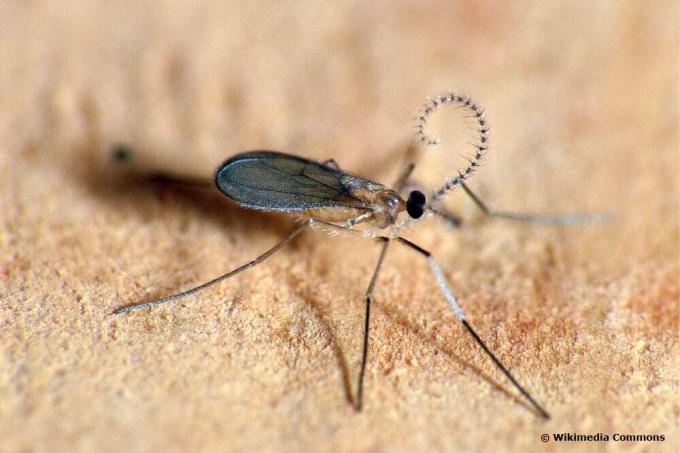
Use: Gall mosquito larvae are sold in specialist shops in granules. They should be applied immediately according to the manufacturer's instructions.
Use lace flies
Lacewing are one of the beneficial insects that every hobby gardener should know. They prefer to eat vinepox mites, but also grain thrips, aphids, mealybugs and other small insects. Lacewing do no harm to plants.
Use: Lacewing can be purchased in specialist shops as eggs or lavas. They should be used immediately after purchase and in accordance with the manufacturer's instructions.
Use neem oil
Neem oil is a vegetable oil obtained from the seeds of the Indian neem tree. The main active ingredient in neem oil is azadirachtin. This influences the mites' hormonal balance.
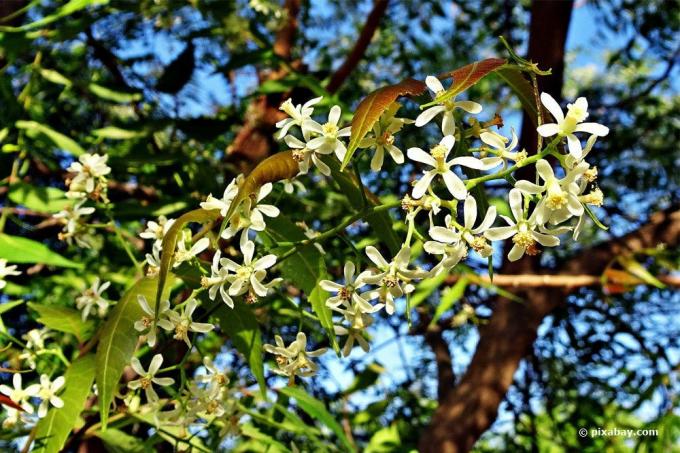
Use: Mix 10 ml neem oil, 5 ml Rimulgan and two liters of water. This mixture is sprayed once a week for four weeks just before the buds burst. Ready-made neem oil / rimulgan mixtures are available commercially.
Tip: Alternatively, you can use rapeseed oil to fight the mite.
Splash nettle broth
All hobby gardeners who rely on natural cultivation know the effectiveness of the nettle. Nettle broth has been used as a vegetable fertilizer for generations. But this home remedy can do even more.
Use: Put the crushed nettles in a suitable container and pour water over them. Cover the jar. Stir the nettle mixture daily. The broth can be used after three to four days. Pour the mixture through a sieve. Use a squeeze bottle and sprinkle your vine thoroughly with it every three days. The spray cure helps fight mites and other pests.
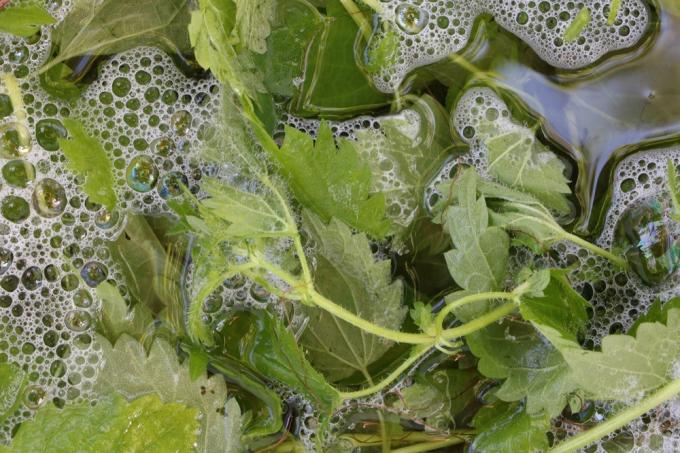
Effective prevention
Knowing the needs of the vinepox mite and its natural enemies can effectively prevent an infestation.
Design your garden as close to nature as possible. Watch out for flowering plants. They provide food for bees, butterflies, ladybugs and other beneficial insects. Create a habitat for insects and small animals. Leave some dead flowers to stand in winter. They give insects winter quarters. Where beneficial insects feel at home, pests have no chance! Leave the leaves under the fruit trees for the winter and give small animals and insects the opportunity to hibernate. Check your plants thoroughly. Remove the affected leaves immediately if you see any damage.
frequently asked Questions
Put up an insect hotel or lacewing house. Plant different flowering plants. If you do not use chemicals in the garden, beneficial insects will settle on their own. Lacewing often find their way into the illuminated apartment. Put them back outside. If you spot lacewings in your gazebo or garage in the fall, let them hibernate there. They do no harm, on the contrary! A single lacewing larva can eat 500 aphids.
The leaves of the vines infested by the mite do not look beautiful, but the infestation does not have a harmful effect on the wine. It may be that the crop yield is slightly lower. Fighting is not absolutely necessary. Enjoy the grapes as usual!
No, the mite does not attack the oaks. The white-gray coating is oak powdery mildew. This form of powdery mildew is caused by a fungus. The trees are not damaged and the ladybugs are happy. Some species of ladybirds only feed on powdery mildew fungi.


